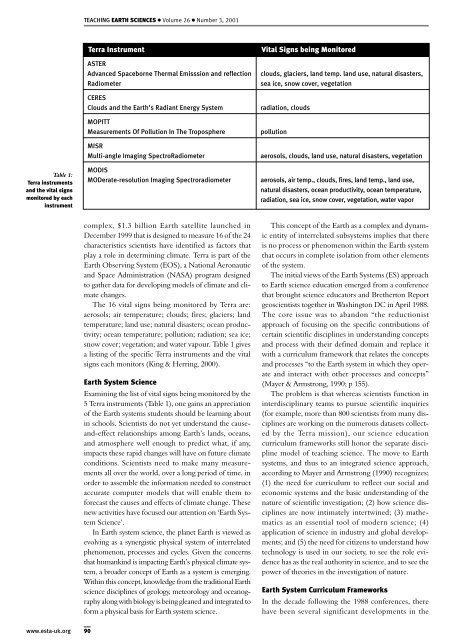teaching - Earth Science Teachers' Association
teaching - Earth Science Teachers' Association
teaching - Earth Science Teachers' Association
You also want an ePaper? Increase the reach of your titles
YUMPU automatically turns print PDFs into web optimized ePapers that Google loves.
TEACHING EARTH SCIENCES ● Volume 26 ● Number 3, 2001<br />
Table 1:<br />
Terra instruments<br />
and the vital signs<br />
monitored by each<br />
instrument<br />
Terra Instrument<br />
ASTER<br />
Advanced Spaceborne Thermal Emisssion and reflection<br />
Radiometer<br />
CERES<br />
Clouds and the <strong>Earth</strong>’s Radiant Energy System<br />
MOPITT<br />
Measurements Of Pollution In The Troposphere<br />
MISR<br />
Multi-angle Imaging SpectroRadiometer<br />
MODIS<br />
MODerate-resolution Imaging Spectroradiometer<br />
Vital Signs being Monitored<br />
clouds, glaciers, land temp. land use, natural disasters,<br />
sea ice, snow cover, vegetation<br />
radiation, clouds<br />
pollution<br />
aerosols, clouds, land use, natural disasters, vegetation<br />
aerosols, air temp., clouds, fires, land temp., land use,<br />
natural disasters, ocean productivity, ocean temperature,<br />
radiation, sea ice, snow cover, vegetation, water vapor<br />
complex, $1.3 billion <strong>Earth</strong> satellite launched in<br />
December 1999 that is designed to measure 16 of the 24<br />
characteristics scientists have identified as factors that<br />
play a role in determining climate. Terra is part of the<br />
<strong>Earth</strong> Observing System (EOS), a National Aeronautic<br />
and Space Administration (NASA) program designed<br />
to gather data for developing models of climate and climate<br />
changes.<br />
The 16 vital signs being monitored by Terra are:<br />
aerosols; air temperature; clouds; fires; glaciers; land<br />
temperature; land use; natural disasters; ocean productivity;<br />
ocean temperature; pollution; radiation; sea ice;<br />
snow cover; vegetation; and water vapour. Table 1 gives<br />
a listing of the specific Terra instruments and the vital<br />
signs each monitors (King & Herring, 2000).<br />
<strong>Earth</strong> System <strong>Science</strong><br />
Examining the list of vital signs being monitored by the<br />
5 Terra instruments (Table 1), one gains an appreciation<br />
of the <strong>Earth</strong> systems students should be learning about<br />
in schools. Scientists do not yet understand the causeand-effect<br />
relationships among <strong>Earth</strong>’s lands, oceans,<br />
and atmosphere well enough to predict what, if any,<br />
impacts these rapid changes will have on future climate<br />
conditions. Scientists need to make many measurements<br />
all over the world, over a long period of time, in<br />
order to assemble the information needed to construct<br />
accurate computer models that will enable them to<br />
forecast the causes and effects of climate change. These<br />
new activities have focused our attention on ‘<strong>Earth</strong> System<br />
<strong>Science</strong>’.<br />
In <strong>Earth</strong> system science, the planet <strong>Earth</strong> is viewed as<br />
evolving as a synergistic physical system of interrelated<br />
phenomenon, processes and cycles. Given the concerns<br />
that humankind is impacting <strong>Earth</strong>’s physical climate system,<br />
a broader concept of <strong>Earth</strong> as a system is emerging.<br />
Within this concept, knowledge from the traditional <strong>Earth</strong><br />
science disciplines of geology, meteorology and oceanography<br />
along with biology is being gleaned and integrated to<br />
form a physical basis for <strong>Earth</strong> system science.<br />
This concept of the <strong>Earth</strong> as a complex and dynamic<br />
entity of interrelated subsystems implies that there<br />
is no process or phenomenon within the <strong>Earth</strong> system<br />
that occurs in complete isolation from other elements<br />
of the system.<br />
The initial views of the <strong>Earth</strong> Systems (ES) approach<br />
to <strong>Earth</strong> science education emerged from a conference<br />
that brought science educators and Bretherton Report<br />
geoscientists together in Washington DC in April 1988.<br />
The core issue was to abandon “the reductionist<br />
approach of focusing on the specific contributions of<br />
certain scientific disciplines in understanding concepts<br />
and process with their defined domain and replace it<br />
with a curriculum framework that relates the concepts<br />
and processes “to the <strong>Earth</strong> system in which they operate<br />
and interact with other processes and concepts”<br />
(Mayer & Armstrong, 1990; p 155).<br />
The problem is that whereas scientists function in<br />
interdisciplinary teams to pursue scientific inquiries<br />
(for example, more than 800 scientists from many disciplines<br />
are working on the numerous datasets collected<br />
by the Terra mission), our science education<br />
curriculum frameworks still honor the separate discipline<br />
model of <strong>teaching</strong> science. The move to <strong>Earth</strong><br />
systems, and thus to an integrated science approach,<br />
according to Mayer and Armstrong (1990) recognizes;<br />
(1) the need for curriculum to reflect our social and<br />
economic systems and the basic understanding of the<br />
nature of scientific investigation; (2) how science disciplines<br />
are now intimately intertwined; (3) mathematics<br />
as an essential tool of modern science; (4)<br />
application of science in industry and global developments;<br />
and (5) the need for citizens to understand how<br />
technology is used in our society, to see the role evidence<br />
has as the real authority in science, and to see the<br />
power of theories in the investigation of nature.<br />
<strong>Earth</strong> System Curriculum Frameworks<br />
In the decade following the 1988 conferences, there<br />
have been several significant developments in the<br />
www.esta-uk.org<br />
90

















